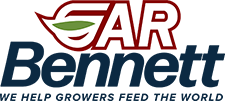Boron is an important micronutrient needed for bud development, flowering, pollen tube growth, and fruit set. Plants take up boron through the roots as boric acid (H3BO3). In its natural state, boron in the soil is in mineral form, which makes it fairly resistant to weathering and thus releases slowly. Boron, as an ion, is held in the soil by positively charged organic matter. Most of our soils have low organic matter, so low boron as shown in a soil analysis is expected. Soil parent material also plays a role in boron presence in soil or irrigation water. Most lab standards for soil boron are from 0.8 to 1.5 ppm.
While boron is needed for crop growth and development, it is important to remember that there is a narrow window between deficiency and toxicity. A typical almond hull sample analysis with boron at less than 80 ppm would be considered deficient, while anything over 200 ppm may be toxic. Tissue and hull sampling should be used to fine tune boron application rates to avoid possible over application.
An easy way to apply boron is during the annual herbicide berm sprays in the fall or winter. The winter rains will allow the boron to move into the rootzone. The boron that is applied during the fall and winter months will not be used during the bloom the following spring, but the tree and hull analysis will have increased boron levels all season long. Typical rates are 5 pounds per acre of either Solubor or Boric acid. Each is a 20% Boron product and 5 pounds supplies one pound actual boron. Consult with your GAR Bennett PCA for an actual recommendation. Retired Tulare County Farm Advisor Bill Peacock talked about annual applications of this type until optimum soil levels and tissue levels are obtained, then cut the rate in half or apply every other year.
While boron deficiency might not be common in many areas of the valley, some locations will still experience it. Common deficiency symptoms in almonds may not be very clear, but a reduced fruit set, non fertilized flower/nut drop, leaf scorch and drop and dieback of the shoot tips are things to look out for; in addition to in season leaf analysis. Since boron does not accumulate in leaves, they are not the only indicators of the boron status in the plant. For that reason, hull analysis should be taken at harvest, with a goal of 120 ppm being adequate. As with all the essential elements, proper balance and presence lead to optimum tree growth and crop yield. Boron acts as the steering wheel in flower development leading to increased nut set. Herbicide applied boron is an easy and relatively inexpensive way to build up boron in the soil profile.

